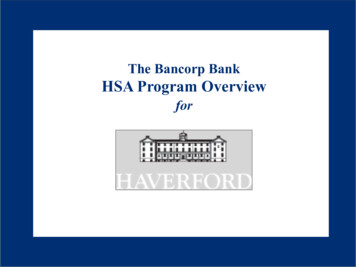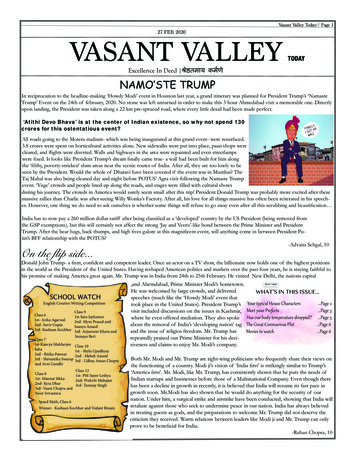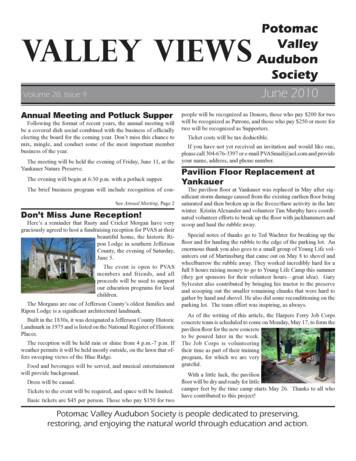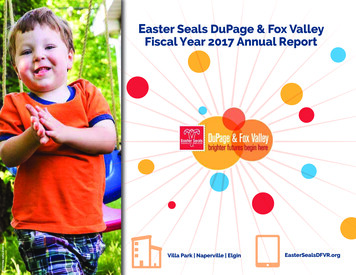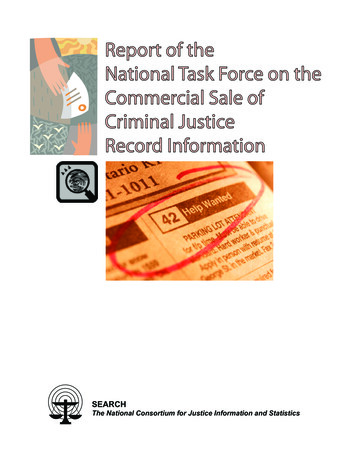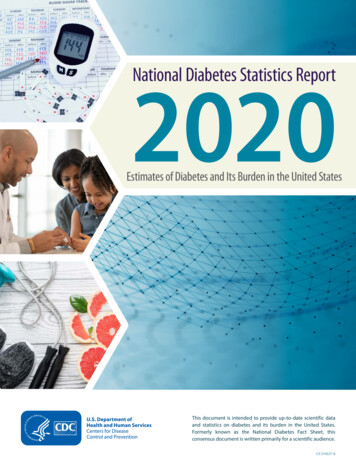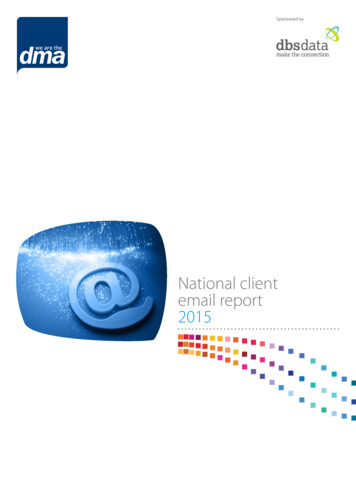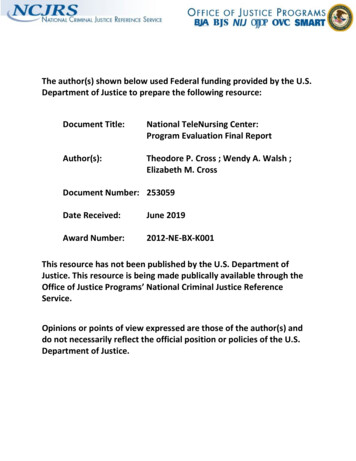
Transcription
Valley National Bancorp Annual Report 2021Form 10-K (NASDAQ:VLY)Published: February 26th, 2021PDF generated by stocklight.com
UNITED STATESSECURITIES AND EXCHANGE COMMISSIONWashington, D.C. 20549FORM 10-K(Mark One) ANNUAL REPORT PURSUANT TO SECTION 13 or 15(d) OF THE SECURITIES EXCHANGE ACT OF 1934 TRANSITION REPORT PURSUANT TO SECTION 13 OR 15(d) OF THE SECURITIES EXCHANGE ACT OF 1934For the fiscal year ended December 31, 2020For the transition period fromtoCommission File Number 1-11277VALLEY NATIONAL BANCORP(Exact name of registrant as specified in its charter)New Jersey(State or other jurisdiction ofIncorporation or Organization)22-2477875(I.R.S. EmployerIdentification Number)One Penn PlazaNew York, NY(Address of principal executive office)10119(Zip code)973-305-8800(Registrant’s telephone number, including area code)Securities registered pursuant to Section 12(b) of the Act:Title of each classTrading SymbolsName of exchange on which registeredCommon Stock, no par valueNon-Cumulative Perpetual Preferred Stock, Series A, no par valueNon-Cumulative Perpetual Preferred Stock, Series B, no par valueVLYVLYPPVLYPOThe Nasdaq Stock Market LLCThe Nasdaq Stock Market LLCThe Nasdaq Stock Market LLCSecurities registered pursuant to Section 12(g) of the Act: NoneIndicate by check mark if the registrant is a well-known seasoned issuer, as defined in Rule 405 of the Securities Act. Yes No Indicate by check mark if the registrant is not required to file reports pursuant to Section 13 or Section 15(d) of the Act. Yes No Indicate by check mark whether the registrant (1) has filed all reports required to be filed by Section 13 or 15(d) of the Securities Exchange Act of 1934 during thepreceding 12 months (or such shorter period that the registrant was required to file such reports), and (2) has been subject to such filing requirements for the past 90days. Yes No Indicate by check mark whether the Registrant has submitted electronically every Interactive Data File required to be submitted pursuant to Rule 405 ofRegulation S-T (§232.405 of this chapter) during the preceding 12 months (or for such shorter period that the registrant was required to submit suchfiles.) Yes No Indicate by check mark whether the registrant is a large accelerated filer, an accelerated filer, a non-accelerated filer, a smaller reporting company, or anemerging growth company. See the definitions of “large accelerated filer,” “accelerated filer,” “smaller reporting company” and "emerging growth company" in Rule12b-2 of the Exchange Act (check one):Large accelerated filerNon-accelerated filer Accelerated filer Smaller reporting companyEmerging growth company If an emerging growth company, indicate by check mark if the registrant has elected not to use the extended transition period for complying with any new orrevised financial accounting standards provided pursuant to Section 13(a) of the Exchange Act. Indicate by check mark whether the registrant has filed a report on and attestation to its management’s assessment of the effectiveness of its internal control overfinancial reporting under Section 404(b) of the Sarbanes-Oxley Act (15 U.S.C. 7262(b)) by the registered public accounting firm that prepared or issued its auditreport. Yes No Indicate by check mark whether the registrant is a shell company (as defined in Rule 12b-2 of the Exchange Act) Yes No The aggregate market value of the voting stock held by non-affiliates of the registrant was approximately 3.1 billion on June 30, 2020.There were 405,611,861 shares of Common Stock outstanding at February 25, 2021.Documents incorporated by reference:Certain portions of the registrant’s Definitive Proxy Statement (the “2021 Proxy Statement”) for the 2021 Annual Meeting of Shareholders to be held April 19,2021 will be incorporated by reference in Part III. The 2021 Proxy Statement will be filed within 120 days of December 31, 2020.
TABLE OF CONTENTSPagePART IItem 1.Item 1A.Item 1B.Item 2.Item 3.PART IIItem 5.Item 6.Item 7.Item 7A.Item 8.Item 9.Item 9A.Item 9B.PART IIIItem 10.Item 11.Item 12.Item 13.Item 14.PART IVItem 15.BusinessRisk FactorsUnresolved Staff CommentsPropertiesLegal Proceedings319303131Market for Registrant’s Common Equity, Related Stockholder Matters and Issuer Purchases of Equity SecuritiesSelected Financial DataManagement’s Discussion and Analysis of Financial Condition and Results of OperationsQuantitative and Qualitative Disclosures about Market RiskFinancial Statements and Supplementary Data:Valley National Bancorp and Subsidiaries:Consolidated Statements of Financial ConditionConsolidated Statements of IncomeConsolidated Statements of Comprehensive IncomeConsolidated Statements of Changes in Shareholders’ EquityConsolidated Statements of Cash FlowsNotes to Consolidated Financial StatementsReport of Independent Registered Public Accounting FirmChanges in and Disagreements with Accountants on Accounting and Financial DisclosureControls and ProceduresOther tors, Executive Officers and Corporate GovernanceExecutive CompensationSecurity Ownership of Certain Beneficial Owners and Management and Related Shareholder MattersCertain Relationships and Related Transactions, and Director IndependencePrincipal Accountant Fees and Services151151151151151Exhibits and Financial Statement SchedulesSignatures151156
PART IItem 1.BusinessThe disclosures set forth in this item are qualified by Item 1A—Risk Factors and the section captioned “Cautionary Statement Concerning ForwardLooking Statements” in Item 7—Management’s Discussion and Analysis of Financial Condition and Results of Operations of this Annual Report on Form10-K (referred to as this "report") and other cautionary statements set forth elsewhere in this report.Valley National Bancorp, headquartered in Wayne, New Jersey, is a New Jersey corporation organized in 1983 and is registered as a bank holdingcompany with the Board of Governors of the Federal Reserve System under the Bank Holding Company Act of 1956, as amended (“Holding CompanyAct”). The words “Valley,” “the Company,” “we,” “our” and “us” refer to Valley National Bancorp and its wholly owned subsidiaries, unless we indicateotherwise. At December 31, 2020, Valley had consolidated total assets of 40.7 billion, total net loans of 31.9 billion, total deposits of 31.9 billion andtotal shareholders’ equity of 4.6 billion. In addition to its principal subsidiary, Valley National Bank (commonly referred to as the “Bank” in this report),Valley owns all of the voting and common shares of GCB Capital Trust III, State Bancorp Capital Trusts I and II, and Aliant Statutory Trust II atDecember 31, 2020 through which trust preferred securities were issued. These trusts are not consolidated subsidiaries. See Note 11 to the consolidatedfinancial statements.Valley advertises and identifies itself under the trade names "Valley Bank" and "Valley".Valley National Bank is a national banking association chartered in 1927 under the laws of the United States. Currently, the Bank has 226 branchesserving northern and central New Jersey, the New York City boroughs of Manhattan, Brooklyn and Queens, Long Island, Florida and Alabama. The Bankoffers a full suite of banking solutions through various commercial, retail, insurance and wealth management financial services products. These productsinclude, but are not limited to, traditional commercial and industrial lending, commercial real estate financing, small business loans, equipment, basicconsumer and commercial deposit products, personal financing solutions such as residential mortgages, home equity loans and automobile financing, aswell as solutions for homeowners associations and a full service line of cash management solutions. The Bank provides a variety of banking servicesincluding automated teller machines, telephone and internet banking, remote deposit capture, overdraft facilities, drive-in and night deposit services, andsafe deposit facilities. In addition, certain international banking services are available to customers including standby letters of credit, documentary lettersof credit and related products, and certain ancillary services such as foreign exchange transactions, documentary collections, foreign wire transfers, aswell as transaction accounts for non-resident aliens.Our primary focus is to build and develop profitable customer relationships across all lines of business and create a convenient and innovativeomni-channel customer experience beyond our traditional branch footprint, including through the use and promotion of our mobile and online serviceofferings, such as our ValleyDirect on-line savings account.Valley National Bank’s subsidiaries are all included in the consolidated financial statements of Valley (See Exhibit 21 at Part IV, Item 15 for a list ofsubsidiaries). These subsidiaries include, but are not limited to: an insurance agency offering property and casualty, life and health insurance; an asset management adviser that is a registered investment adviser with the Securities and Exchange Commission (SEC); a title insurance agency in New York which also provides services in New Jersey; subsidiaries which hold, maintain and manage investment assets for the Bank; a subsidiary which specializes in health care equipment lending and other commercial equipment leases; and a subsidiary which owns and services New York commercial loans.The Bank’s subsidiaries also include real estate investment trust subsidiaries (the "REIT" subsidiaries), which own real estate related investmentsand a REIT subsidiary, which owns some of the real estate utilized by the Bank and related real estate investments. Except for Valley’s REIT subsidiariesand Valley's insurance agency (10% of which is owned by the insurance agency's co-CEOs), all subsidiaries mentioned above are directly or indirectlywholly owned by the Bank. Because each REIT must have 100 or more shareholders to qualify as a REIT, each REIT has issued less than 20 percent ofits outstanding non-voting preferred stock to individuals, most of whom are current and former Bank employees. The Bank owns the remaining preferredstock and all the common stock of the REITs.
Recent AcquisitionsValley has grown significantly in the past several years primarily through bank acquisitions that expanded our branch footprint in New Jersey andFlorida. Recent bank transactions are discussed further below.Oritani Financial Corp. On December 1, 2019, Valley completed its acquisition of Oritani Financial Corp. ("Oritani") and its wholly-ownedsubsidiary, Oritani Bank. Oritani had approximately 4.3 billion in assets, 3.4 billion in net loans, 2.9 billion in deposits, after purchase accountingadjustments, and a branch network of 26 locations. The acquisition represented a significant addition to Valley's New Jersey franchise, and meaningfullyenhanced its presence in the Bergen County market. The common shareholders of Oritani received 1.60 shares of Valley common stock for each Oritanishare that they owned prior to the merger. The total consideration for the acquisition was approximately 835 million, consisting of approximately 71.1million shares of Valley common stock and the outstanding Oritani stock-based awards.USAmeriBancorp, Inc. On January 1, 2018, Valley completed its acquisition of USAmeriBancorp, Inc. (USAB) headquartered in Clearwater,Florida. USAB, largely through its wholly-owned subsidiary, USAmeriBank, had approximately 5.1 billion in assets, 3.7 billion in net loans and 3.6billion in deposits, after purchase accounting adjustments, and maintained a branch network of 29 offices. The acquisition represented a significantaddition to Valley’s Florida presence, primarily in the Tampa Bay market. The acquisition also brought Valley to the Birmingham, Montgomery, andTallapoosa areas in Alabama, where USAB maintained 15 of its branches. The common shareholders of USAB received 6.1 shares of Valley commonstock for each USAB share they owned prior to merger. The total consideration for the acquisition was approximately 737 million, consisting of 64.9million shares of Valley common stock and the outstanding USAB stock based awards.Impact of COVID-19Valley's primary market areas within New Jersey, New York, Florida and Alabama have all experienced significant outbreaks and resurgences ofthe disease caused by the novel coronavirus (COVID-19) and disruptions from the pandemic. The COVID-19 pandemic and any preventative orprotective actions that Valley or its customers have taken or may take in response resulted and may continue to result in extended periods of disruption toValley, its customers, service providers, and third parties. The full extent and duration of the adverse impacts of COVID-19 pandemic on Valley'sbusiness, financial position, results of operations, and prospects are currently unknown, but could be significant. As of the date of this report, the bankingand financial services industries have been deemed essential businesses in the jurisdictions in which Valley operates. Although our branches are nowopen, we continue to implement various protocols and practices imposed to safeguard the health and wellness of customers and employees and tocomply with applicable government directives. However, the imposition and the extent of any further restrictions on our operations, and compliancetherewith could have a material effect on Valley’s business. Valley cannot predict whether and to what extent governmental and nongovernmentalauthorities will continue to implement policy measures or further legislative relief to assist Valley and its customers and the failure to do so could haveadverse effects on Valley's business.The Paycheck Protection Program (PPP) provided for in the Coronavirus Aid, Relief, and Economic Security (CARES) Act, as supplemented by thePaycheck Protection Program and Health Care Enhancement Act (Enhancement Act), was designed to aid small- and medium-sized businesses throughfederally guaranteed loans distributed through banks. These loans were intended to offset payroll and other costs to help those businesses remain viableand allow their workers to pay their bills. Valley National Bank is a certified Small Business Administration (SBA) lender and facilitated approximately13,000 SBA-approved PPP loans with balances totaling 2.2 billion as of December 31, 2020. While difficult to accurately predict, we expect the majorityof these loans to be forgiven in accordance with rules, application and documentation requirements for this program.Business SegmentsOur business segments are reassessed by management, at least on an annual basis, to ensure the proper identification and reporting of ouroperating segments. Valley currently reports the results of its operations and manages its business through four business segments: commercial lending,consumer lending, investment management, and corporate and other adjustments. Valley’s Wealth Management Division comprised of trust, assetmanagement and insurance services, is included in the consumer lending segment. See Note 21 to the consolidated financial statements for details ofthe financial performance of our business segments. We offer a variety of products and services within the commercial and consumer lending segmentsas described below.Commercial Lending SegmentCommercial and industrial loans. Commercial and industrial loans totaled approximately 6.9 billion and represented 21.3 percent of the totalloan portfolio at December 31, 2020. We make commercial loans to small and middle market
businesses most often located in New Jersey, New York, Florida and Alabama. Loans originated from Florida accounted for approximately 28 percent oftotal commercial and industrial loans at both, December 31, 2020 and 2019. A significant proportion of Valley’s commercial and industrial loan portfolio isgranted to long-standing customers of proven ability, strong repayment performance, and high character. Underwriting standards are designed to assessthe borrower’s ability to generate recurring cash flow sufficient to meet the debt service requirements of loans granted. While such recurring cash flowserves as the primary source of repayment, most of the loans are collateralized by borrower assets intended to serve as a secondary source ofrepayment should the need arise. Anticipated cash flows of borrowers, however, may not occur as expected and the collateral securing these loans mayfluctuate in value. In the case of loans secured by accounts receivable, the ability of the borrower to collect all amounts due from its customers may beimpaired. Our loan decisions include consideration of a borrower’s willingness to repay debts, collateral coverage, standing in the community and otherforms of support. Strong consideration is given to long-term existing customers that have maintained a favorable relationship with the Bank. Commercialloan products offered consist of term loans for equipment purchases, working capital lines of credit that assist our customers’ financing of accountsreceivable and inventory, and commercial mortgages for owner occupied properties. Working capital advances are generally used to finance seasonalrequirements and are repaid at the end of the cycle. Short-term commercial business loans may be collateralized by a lien on accounts receivable,inventory, equipment and/or partly collateralized by real estate. Short-term loans may also be made on an unsecured basis based on a borrower’sfinancial strength and past performance. Whenever possible, we obtain the personal guarantee of the borrower’s principals to mitigate the risk.Unsecured loans, when made, are generally granted to the Bank’s most creditworthy borrowers. Unsecured commercial and industrial loans totaled 2.7billion (including 2.2 billion of SBA guaranteed PPP loans) at December 31, 2020. In addition, we provide financing to the health care and industrialequipment leasing market through our leasing subsidiary, Highland Capital Corp.The commercial portfolio also includes approximately 90.6 million and 6.9 million of New York City and Chicago taxi medallion loans atDecember 31, 2020, respectively. All of these loans are on non-accrual status due to ongoing weakness exhibited in the taxi industry caused by strongcompetition from alternative ride-sharing services and the economic stress caused by COVID-19. At December 31, 2020, the non-accrual taxi medallionloans totaling 97.5 million had related reserves of 66.4 million, or 68.1 percent of such loans, within the allowance for loan losses. We continue toclosely monitor this portfolio and negative trends in the market valuations of the underlying taxi medallion collateral and a decline in borrower cash flows,among other factors, could result in additional charges to increase the reserves associated with this loan portfolio. See the “Non-performing Assets”section of “Item 7. Management’s Discussion and Analysis of Financial Condition and Results of Operations” (MD&A) for additional information regardingour taxi medallion loans.Commercial real estate loans. Commercial real estate and construction loans totaled 18.5 billion and represented 57.3 percent of the total loanportfolio at December 31, 2020. We originate commercial real estate loans that are secured by various diversified property types across the New Yorkmetropolitan area (New Jersey, New York and Pennsylvania) along with Florida and our Alabama footprint. Property types in this portfolio range frommulti-family residential properties to non-owner occupied commercial, industrial/warehouse and retail. Loans originated from Florida lending represented26 percent of the total commercial real estate loans at December 31, 2020 as compared to 25 percent of such loans at December 31, 2019. Loans aregenerally written on an adjustable basis with rates tied to a specifically identified market rate index. Adjustment periods generally range bet
Florida. Recent bank transactions are discussed further below. Oritani Financial Corp. On December 1, 2019, Valley completed its acquisition of Oritani Financial Corp. ("Oritani") and its wholly-owned subsidiary, Oritani Bank. Oritani had approximately 4.3 billion in assets, 3.4 billion i
